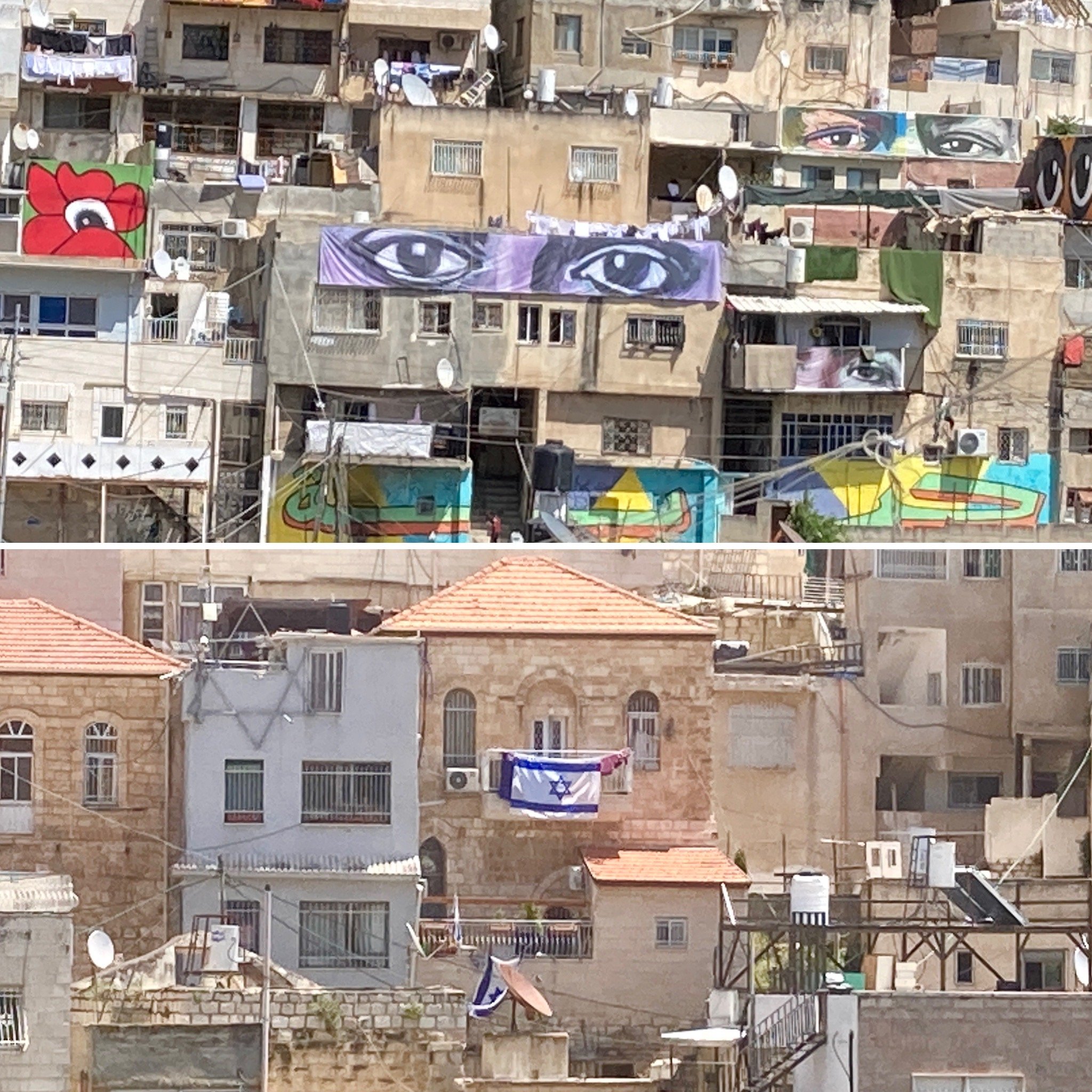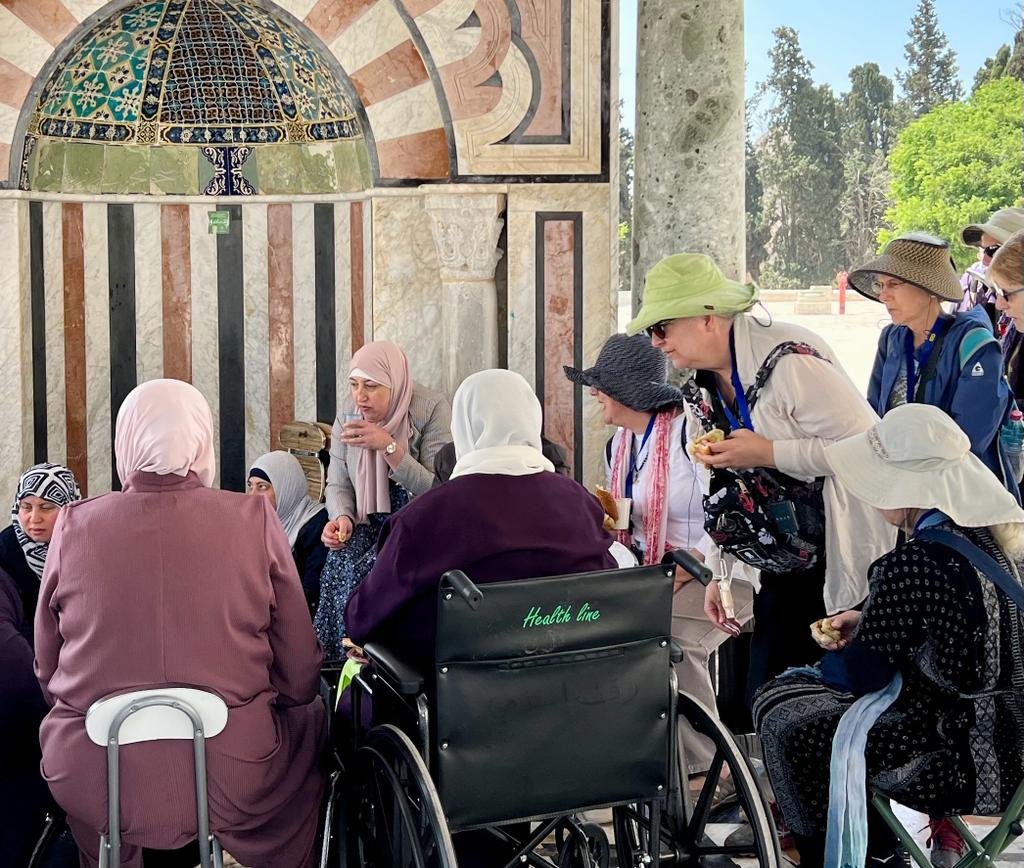A week ago, nearly two dozen of us, friends and members of this congregation, welcomed Shabbat in Jerusalem, in Yerushalayim, a city with an ancient Canaanite name meaning, probably, City of Peace.
We strolled gently from our hotel, a former British-built YMCA, still referred to broadly as the Yimka, through the quieting streets lined with bougainvillea and scented with jasmine, until we reached Kehilat Har-El, the oldest reform congregation in Jerusalem.
There we were welcomed warmly and we welcomed the Shabbat with familiar melodies and unfamiliar ones. We heard the words of the rabbi, as she offered a kind of love song to the city itself, naming its complexity and insistently loving it anyway.
Jerusalem was on her mind as a topic because this week and actually today was Yom Yerushalayim, Jerusalem Day. It is the day that marks the reunification of Jerusalem in the Six Day War in 1967. For the 19 years prior to that, the city was divided. The United Nations, when creating their Partition Plan for Israel and Palestine, had envisioned a unified Jerusalem under international control. But the 1948 War of Independence change things and Jerusalem ended up split: half in Israeli hands, which were new hands, and half in Jordanian. Our holiest site, the Western Wall, which is a small piece of the retaining wall surrounding our ancient Temple, fell under Jordanian control. This was a hard thing for the Jews of the newly minted Jewish state. In the 1900 years before that, while there wasn’t any Jewish autonomy, Jews had still been able to visit this spot freely.
In 1967, that fast and violent war changed the map. Jerusalem was unified under Israeli control, and that event 56 years ago is what was celebrated today and all week.
But as the members of the Ner Shalom group could tell you, Jerusalem does not feel unified. It is a divided city, the western parts primarily Jewish and East Jerusalem primarily Muslim and Palestinian. One could easily imagine a peaceful coexistence of Jews and Muslims,. One could easily imagine a diverse and thriving Jerusalem, much as is implied in Psalm 122 where it says, “Jerusalem is a city built as a binding together.” But the war for control of Jerusalem has never ended.
Jewish settlers have begun to populate East Jerusalem in a variety of ways. They’ve built settlements beyond the Arab neighborhoods, and those settlements have grown into towns, suburbs, actually that now surround and hem in the Palestinian neighborhoods, which are not allowed to similarly expand or develop. The Jews of these neighborhoods and towns are largely not there for ideological reasons; these are new developments, new places to live, bedroom communities. A hop, skip, and jump from work in the center of town.
Other settlers have bought houses in long-standing Palestinian neighborhoods of East Jerusalem, characterizing the project as a kind of innocuous gentrification, when in fact it is a conscious provocation. A project to slowly push the Arabs out not through war, but through real estate.
We visited some of these places just last week. We walked through the East Jerusalem Arab neighborhood of Silwan and saw houses occupied by Jewish families not for the goal of peaceful coexistence, but as a step in turning Jerusalem entirely Jewish. Those families have – and have to have – round-the-clock security to protect them and many of them hang immense Israeli flags on the walls of their houses, visible from a great distance, the way you might plant a flag on the peak of Everest.
Meanwhile, many of the Palestinian families in the same neighborhood are under longstanding eviction orders, connected to a law preventing Arab families who fled in 1948 from reclaiming ownership of their own homes, even when they in fact returned to them and have been living in them.
In response to the flags on the walls of the Jewish homes, Palestinian artists have painted eyes on many of their homes. Like the oculist billboard in The Great Gatsby, they watch. They watch silently as if saying, “We do not have the muscle to stop what you are doing, but we see it. We see it.”
We met with one of these East Jerusalem Jewish settlers, a young American rabbi, who represents an organization helping Jews buy up contested property in Palestinian East Jerusalem. He described their work as peaceful, but the handgun cavalierly protruding from his belt made his words ring false.
I don’t know what to do about any of this division. Jerusalem is still, to my mind, a place of possibility. A place of simple beauty and simple kindnesses. We visited the Temple Mount, where the mosque called The Dome of the Rock stands on the spot where Abraham nearly sacrificed a son, and where our First and Second Temples stood. It was a day of blazing heat and sunlight and a few of the women in our group quietly encroached on a shelter where large group of Muslim women shared a carpet and a beautiful lunch. Of the many things that could have happened, what did in fact happen was that the Muslim women offered Rebecca and Marthe and Toby places to sit and food to eat. Eventually a half dozen more of the women from Ner Shalom were invited into the party. This happened without any shared language other than smiles and outstretched hands. The Ner Shalom women knew what a precious moment this was. So did the Muslim women, pulling out their phones and taking pictures. This went on for 20 minutes, maybe more, until a guard shooed us away because prayer was about to begin.
That moment felt like a seed of hope daring to plant itself in the supposedly toxic soil. It was a vision in small scale of what could happen in large scale. What could happen if the dominant value at play in Jerusalem was not control but generosity. The hearts that could be uplifted. The songs in Hebrew and Arabic and other holy tongues that could fill the streets. The shared food, the shared joy, the shared grief.
If Yom Yerushalayim, Jerusalem Day, is to be celebrated, it has to be celebrated as a vision. A vision of a city (a country, a land, a world) where no one is being forced out, a city where our differences give rise to joy and curiosity. This particular city of stone and flowers has fed the spirits of its visitors and pilgrims and residents for many thousands of years. It has also fed their ambitions. But maybe on Yom Yerushalayim, we pray that the golden light that flows through this place might illuminate our hearts, melting the walls that keep us from giving and keep us from trusting. Let us do this for our own sakes and the sake of all who are inextricably bound together by love of this holy place. And in the words of Psalm 122 we might say:
שַׁ֭אֲלוּ שְׁל֣וֹם יְרוּשָׁלָ֑ם יִ֭שְׁלָ֗יוּ אֹהֲבָיִךְ
יְהִי־שָׁל֥וֹם בְּחֵילֵ֑ךְ שַׁ֭לְוָ֗ה בְּאַרְמְנוֹתָיִךְ
לְמַעַן־אַחַ֣י וְרֵעָ֑י אֲדַבְּרָה־נָּ֖א שָׁל֣וֹם בָּךְ
לְ֭מַעַן בֵּית־יְהֹוָ֣ה אֱלֹהֵ֑ינוּ אֲבַקְשָׁ֖ה ט֣וֹב לָךְ
Pray for the peace of Jerusalem;
that all who love you may find tranquility.
May peace be found within your walls,
serenity within your palaces.
For the sake of my kin and companions,
I pray for your well-being.
For the sake of the house of Adonai our God
I seek your good.


